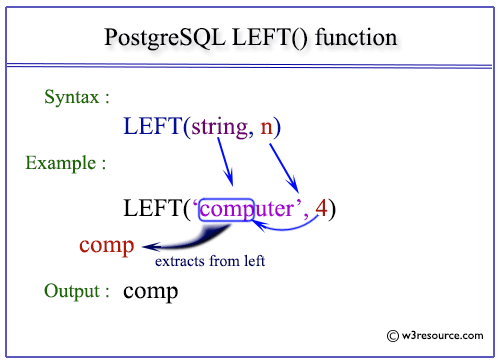PostgreSQL LEFT() function
LEFT() function
The PostgreSQL left() function is used to extract n number of characters specified in the argument from the left of a given string. When the value of n is negative, the extraction will happen from left except last n characters.
Uses of LEFT() Function
- Extracting Substrings: Retrieve a specific number of characters from the start of a string.
- Handling Negative Values: Extract characters from the left side while excluding a specified number of characters from the end.
- Filtering Data: Use in WHERE clauses to filter results based on a prefix match.
- Data Formatting: Format and display portions of text data in a structured manner.
- Combining with Other Functions: Use alongside other string functions for complex text manipulations.
- Data Validation: Check for specific patterns or prefixes in text data for validation purposes.
Syntax:
left(string,n)
PostgreSQL Version: 9.3
Visual Presentation of PostgreSQL LEFT() function
Example: PostgreSQL LEFT() function:
In the example below, the left function extracted 3 characters from the left of the string 'w3resource'.
SQL Code:
SELECT left('w3resource',3)
AS "Extract 3 characters from the left";
Output:
Extract 3 characters from the left ------------------------------------ w3r (1 row)
Example: PostgreSQL LEFT() function using negative value:
In the example below, the left function extracted all the characters from the left side except 3 rightmost characters from the string 'w3resource', because the value of extracting character number is negative.
SQL Code:
SELECT left('w3resource',-3)
AS "Extract all characters except 3 rightmost";
Output:
Extract all characters except 3 rightmost ------------------------------------------- w3resou (1 row)
Example: PostgreSQL LEFT() function using columns of table:
Sample Table: employees
If we want to display the first_name, last_name for those employees whose first 3 characters of their name contain 'Nan' from employees table, the following sql statement can be used:
SQL Code:
SELECT first_name, last_name
FROM employees
WHERE left(first_name,3)='Nan';
Output:
first_name | last_name ------------+----------- Nancy | Greenberg Nanette | Cambrault Nandita | Sarchand (3 rows)
Previous: INITCAP function
Next: LENGTH function

